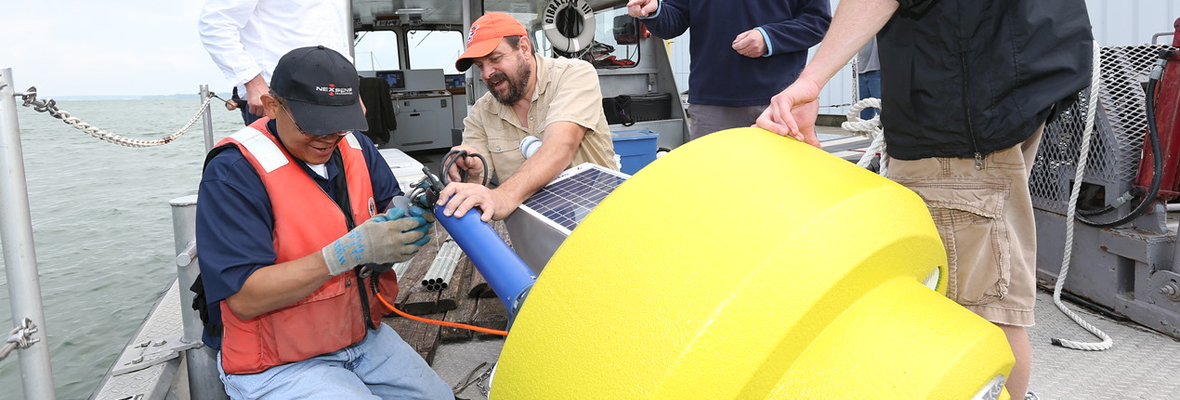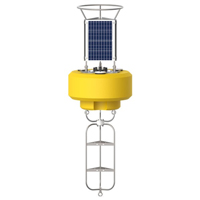Buoy-based monitoring and research equipment is reliable, simple to use, and promises highly accurate performance despite punishing conditions. This is especially important for coastal buoy monitoring systems, which are subjected to harsh and unpredictable weather and other forces as a matter of course. In this post, we’ll discuss the basics of why to use buoy-based monitoring systems for coastal applications, and which varieties work best for this kind of deployment.
Why Data Buoys for Coastal Deployments?
A typical water monitoring buoy station is made up of several components, including mooring hardware, a buoy platform, solar power, data logger, telemetry equipment, sondes, a temperature string, and sensors. By customizing the features and form of the environmental monitoring buoy platform you deploy, you can create the ideal buoy for your project’s budget and goals.
The ideal coastal water monitoring buoy station remains light enough to deploy readily but is larger, heavier, and more stable than its inland cousins so it can withstand high winds and storms. As stability and reliable data are basically job one for any such station, the size and customizable nature of the buoys are critical to the success of many applications.
Over time, the needs of any deployment can change. This is where the importance of the data buoy’s flexibility comes into play. Buoys and instruments that can be deployed with them are flexible, and you can change how you deploy a buoy system over time as water quality monitoring and research priorities fluctuate and regulations change. Larger buoys can house hundreds of sensors, opening up the possibilities.
Data buoys also offer streaming data in real-time. You can sample your waterway as often as every minute, 24 hours a day, 7 days a week, 365 days a year, guaranteeing a nearly constant stream of high-quality data. This allows you to understand how water quality is changing in real-time, and adjust accordingly. Real-time data access means problems are solved more readily, and potentially dangerous conditions are rectified sooner. Real-time access and streaming data also make it easier to share your information with the public.
Data buoys allow you to stay independent of a power source and deploy anywhere, as needed. Battery and solar power options and a range of telemetry choices mean remote sensor control and data access, even along a remote shore. Your buoy platforms can also stay connected to online systems and servers, communicating your data and conducting routine maintenance with minimal interruption.
Finally, thanks to data management software tools, you can start organizing and interpreting data as soon as you get it. Use the WQData web datacenter, a secure option for users to store, present, and create graphs of the data. You can also ensure that the software alerts the right manager should water quality parameters exceed set limits, eliminating the call for continuous data monitoring.
NexSens Coastal Buoy Monitoring Systems
When we say “coastal,” we generally mean either on or connected to the ocean. These tend to be more difficult environments, so we generally recommend using the NexSens CB-650 or larger in coastal projects.
NexSens CB-650, NexSens CB-950, and NexSens CB-1250 data buoys are specifically designed for water monitoring systems deployed in offshore environments. At the center of these data buoys are a floating platform that supports environmental monitoring sensors both subsurface and topside. Deploy Doppler current meters, multi-parameter sondes, Temperature strings, wave sensors, weather stations, and other monitoring instruments quickly and easily in coastal waters and nearby areas.
NexSens coastal buoy monitoring systems are built with an inner core of cross-linked polyethylene foam with a tough polymer skin protecting it. Your coastal buoy monitoring system has several wireless options for getting your data back to shore, including cellular, Iridium satellite data transmission, spread spectrum radio, and WiFi. Analog and digital telemetry options include RS-232, SDI-12, RS-485, mA, VDC, and pulse count.
From there, however, each of these coastal buoy monitoring systems starts diverging to give you more customizability. Each model guards subsurface instruments—and allows them to be quickly deployed—as they pass through three sensor holes with female NPT threads, but they vary in size. The CB-650 has sensor holes that are 4 inches in diameter, while the CB-950’s holes are 6 inches in diameter, and the CB-1250’s sensor holes are 8 inches across.
Each coastal buoy monitoring system also has a central data well that accommodates data loggers, batteries, sensors, and other tools. Each central well is 10 inches in diameter, but the CB-650’s is 21.5 inches tall, while that of the CB-950 has more capacity at 25.5 inches tall, and the CB-1250’s central data well boasts the most volume with a height of 27.5 inches.
Topside, the NexSens CB-650 features a stainless steel tower 40 inches tall that includes three unbreakable 30-watt 12VDC solar panels. The tower and panels grow in size and capacity for the CB-950, which features a tower 45 inches tall and three 40-watt 12VDC solar panels. The CB-1250’s tower stands 55 inches tall and carries three 55-watt 12VDC solar panels. The 650 lb., 950 lb., and 1,250 lb. buoyancy buoys are designed to work with data loggers by NexSens.
The Bottom Line
Coastal and marine monitoring applications demand instrumentation that can and does last despite deployment in harsh environments. NexSens coastal buoy monitoring systems are designed to meet the demands placed on them during longer-term deployments, despite the harshest of conditions and the most stringent requirements for data.
We work with our clients to customize our coastal buoy monitoring systems. This allows them to do more you year after year, as modular platforms with sensors that are on point for your application today but can also be changed later on. You can also deploy a total marine environmental monitoring system right now, combining instruments. Reach out to a Fondriest team member to find out more about which coastal buoy monitoring system will work best in your deeper water or harsh coastal environment for an extended deployment.
Equipment
The NexSens CB-650 Data Buoy is designed for deployment in lakes, rivers, coastal waters, harbors, estuaries and other freshwater or marine environments.
The X3 data logger offers the latest in real-time monitoring technology with wireless communication, a large plug-and-play sensor library, and ultra-low power consumption.
WQData LIVE is a web-based project management service that allows users 24/7 instant access to data collected from remote telemetry systems.





0 comments